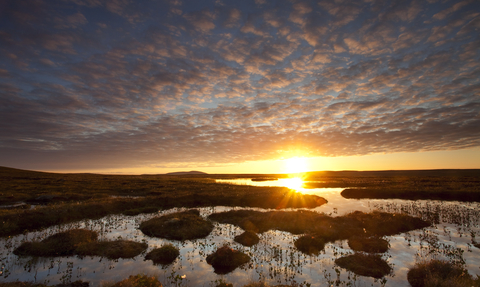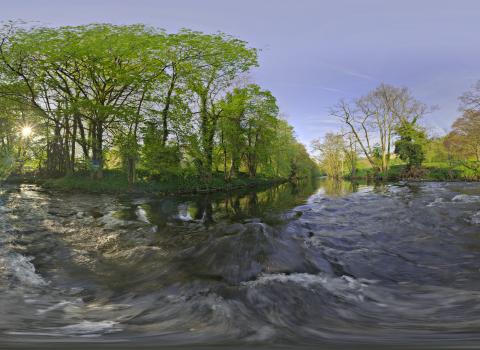
Mark Hamblin/2020 VISION
Nature Based Solutions
We are in the middle of a climate and nature emergency, and the two are inextricably linked. Locally, nationally and globally, humanity is facing multiple changes from a collapse of natural systems and a warming global climate. This is driving nature’s decline, and the loss of wildlife and wild places leaves us ill-equipped to deal with the impacts of localised flooding and longer periods of drought. The physical and mental wellbeing of people is also being affected, particularly in more vulnerable parts of society, and we will not be able to tackle these problems unless we let nature help.
Nature Based Solutions, and creating healthier habitats through actions such as the restoration of forests, peatlands and wetlands, can help protect local communities from flood waters, improve people’s health and wellbeing, and maintain healthy soils, clean water and the pollinators needed for our crops.
The UK has a target of net zero greenhouse gas emissions by 2050. Nature can make a massive contribution to achieving this, or an even more ambitious target – but only if we restore our damaged ecosystems.
What we are doing:
Natural Flood Management
In England alone, more than 5 million properties – one in six – are at risk of flooding.
The approaches we have relied on in the past are no longer enough to protect us from the risk of floods that we may experience today and into the future.
Traditional flood defences like flood walls and embankments confine water to river channels, preventing it spilling out in particularly vulnerable areas like towns and cities. In rural areas there can be opportunities to set these embankments back, allowing water to flow out into the floodplain. This creates extra capacity to hold water and prevents it from rushing to built-up areas downstream.
The modification of our landscape to include hard paving of urban areas and the conversion of natural habitat to other land uses means that our landscape is less able to capture water by holding it in soils and vegetation or allowing it to percolate through into permeable rocks below. Instead, water flows overland, quickly collecting in rivers and then overwhelming flood defences that can no longer cope.
By creating and restoring ponds and wetlands, enhancing soils so that they can hold more water, planting trees to slow overland flows and aid infiltration, and constructing woody features, like leaky dams, in channels and floodplains to hold back water, we can slow the flow of water.
Putting these solutions into practice
A range of habitats or habitat features help to hold water in the landscape, including:
- Woods, trees, hedgerows: tree cover intercepts rainfall, so it hits the ground with less force and doesn’t run off so readily. Trees take up water for growth, allowing some to evaporate back into the atmosphere, but more importantly, their root systems help water to penetrate into the soil, again reducing runoff.
- Ponds, scrapes and wetlands: Wetlands and hollows in the landscape collect water, holding it during wet periods, and releasing it slowly during dry periods.
- Peat bogs; Sphagnum moss can hold 20x its weight in water!
- Wet grasslands: Rough, tussocky grasslands like the Culm grasslands in Devon are extremely effective at storing water. Research has shown that 11 times more water leaves intensively managed grasslands than Culm grasslands during storms, increasing the risk of flooding downstream. Bare soils will allow even more runoff.
By working with nature, Natural Flood Management not only helps reduce flood risk but also brings many other benefits. This includes improved water quality, enhanced biodiversity, and increased carbon storage within soils and vegetation.
The impacts of drought can also be reduced through Natural Flood Management. Ponds and wetlands store water and provide a buffer against drought conditions by gradually releasing water during dry periods. Slowing down and spreading out the flow of water in rivers and natural habitats allows more time for water to infiltrate into soils. This helps maintain moisture levels in soils for longer and recharges aquifers beneath the surface. During severe droughts, wetland habitats also provide refuge for wildlife and maintain critical ecological functions.
The multiple benefits of Natural Flood Management are becoming ever more critical as Derbyshire faces extreme weather events more frequently due to our changing climate.
Biodiversity Net Gain (BNG)
Conservation is changing. We’re moving from protecting pockets of high-quality nature reserves, to the protection and creation of whole landscapes that are ecologically sound and resilient, and allow nature to thrive. Biodiversity Net Gain is an approach used to improve a site's biodiversity value. Once applied, a completed site will have a positive ecological impact, delivering improvements through habitat creation or enhancement after avoiding or mitigating harm.
Our laws are changing to reflect this shifting conservation approach and society’s desire to ensure that the next generation inherits a natural world which is in a better condition than now.
To make sure this happens, the Environment Act 2021 mandates that all developments which are approved under the Town and Country Planning Act (such as housing developments and commercial sites) leave nature in a better state than before the development. By autumn 2023, these projects will need to achieve at least 10% biodiversity net gain (BNG) in order to gain planning permission.
What are the key components of BNG?
Each project will still need to ensure that they are adhering to the ecological mitigation hierarchy:
- To avoid impacting biodiversity resources
- mitigate any unavoidable impacts
- compensate for any remaining impacts
But, they will also need to demonstrate that there will be a minimum 10% uplift in biodiversity as a result of the project. If the uplift cannot be delivered within the project’s own boundaries, then biodiversity enhancements can be made off-site or via biodiversity credits. The habitat improvement associated with BNG must be secured for at least 30 years. This is addition to other requirements and not instead of them.
Find out more about BNG below:
Nutrient Neutrality
Nutrient pollution is a big issue for many of our wild places in Derbyshire. In freshwater habitats and estuaries, increased levels of nutrients, especially nitrogen and phosphorus, can speed up the growth of certain plants, impacting wildlife.
Pollution from nutrients can arise from the way that land is used in areas close to water bodies (known as ‘water catchments’). Where sites are already in unfavourable condition, extra wastewater from new housing developments can make matters worse.
Nutrient neutrality is a means of ensuring that a development plan or project does not add to existing nutrient burdens within catchments, so there is no net increase in nutrients as a result of the plan or project. The advice from Natural England means that new residential development must achieve ‘nutrient neutrality’.
Carbon Sequestration
Wetlands are vitally important for many things – some may be familiar, like habitat for wading birds, but some might be less familiar, like carbon capture. There are areas of specific kind of wetland, created by layers of plants which sink under the water when they die, trapping carbon safely away from the atmosphere.
Peatlands cover much less area but store more carbon than all the world’s forests. However, when the peat warms and dries, soil microbes which react that carbon with oxygen become active, and peat starts to emit carbon rather than absorb it. Peatlands are amazingly wild places, home to birds, insects and unusual plants that aren't found anywhere else. They provide benefits for people too; the UK’s peatlands store around 3.2 billion tonnes of carbon, and we get 70% of our drinking water from peatland river catchments.
Peatlands are tough places to live but wildlife still thrives here including colourful sphagnum mosses, beautiful large heath butterflies and the black darter dragonfly. Peatlands provide important nesting and feeding grounds for many wading birds such as dunlin, curlew and greenshank.
People often drain peat to grow crops because it’s fertile, but this brings inactive carbon back into the cycle and into the atmosphere. But we can reverse some of this by wetting the soil again and leaving that carbon safely where it belongs – in the soil, rather than the sky. Sadly, our peatlands have been suffering for many years and currently around 80% of the UK's peatlands are in poor condition. A major cause of damage in the uplands is drainage, where channels are cut into the peat to move rainwater off the land, drying it out to enable sheep grazing, grouse shooting or tree plantations. Damage can also be caused by burning, air pollution and over-grazing by sheep themselves. Many lowland peatlands are drained for farming, and in some lowland areas, peat sadly continues to be cut or dug out to make compost, sold in garden centres or used in commercial horticulture. The Wildlife Trusts are working across the country to restore these amazing habitats.
Wellbeing
Research has proven that spending time outdoors in nature is great for our physical and mental health. We also know that connecting with nature can improve our wellbeing.
We would like to help and encourage everyone in Derbyshire to access wildlife-rich places as part of their everyday lives, or as often as possible. People who connect with nature every day are more active and mentally resilient, experience reduced social isolation and loneliness and have better all-round health.
Find out more about wild wellbeing by clicking the link below.


